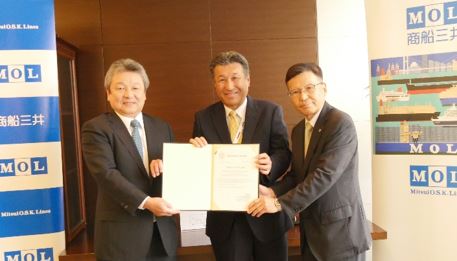
Certificate presentation ceremony – From Left: ClassNK Senior Executive Vice President Toshiyuki Shigemi, MOL Senior Managing Executive Officer Yoshikazu Kawagoe, Oshima Shipbuilding President Eiichi Hiraga
“Wind Challenger” Design Acquires Preliminary Approval ~ Realizing Japan’s 1st Large Cargo Ship with ‘Sail’, Aiming at Reduction of GHGs ~
TOKYO—Mitsui O.S.K. Lines, Ltd. (MOL; President & CEO: Junichiro Ikeda) today announced that MOL and Oshima Shipbuilding Co., Ltd. (President: Eichi Hiraga; Headquarters: Saikai-shi, Nagasaki Prefecture) have jointly obtained “Approval In Principle (AIP)” from Nippon Kaiji Kyokai (ClassNK; Chairman: Koichi Fujiwara; Headquarters: Chiyoda-ku, Tokyo) for the design of a hard sail system. The system converts wind energy to propulsive force with telescopic hard sail, and is a fundamental technology of the “Wind Challenger Project” (Note 1) that MOL and Oshima Shipbuilding are spearheading.
Along with other participating organizations (Note 2), MOL and Oshima Shipbuilding have played a central role in research and development on the Wind Challenger Project, which aims to reduce greenhouse gas (GHG) emissions by using wind energy. Obtaining the AIP marks the completion of the initial design related to the sail structure and controls.
MOL and Oshima Shipbuilding will continue to move toward a detailed design and implementation for the Wind Challenger Project, with the aim to launch of a newbuilding vessel equipped with a hard sail. That would reduce the vessel’s GHG emissions by about 5% on a Japan-Australia voyage, and about 8% on Japan-North America West Coast voyage. The long-term goal is to develop a widely accepted solution to achieve the IMO target (Note 3) in combination with other measures to reduce GHGs by equipping vessels with multiple sails.
Through this project, MOL and Oshima Shipbuilding will establish one of the technological choices for GHG reduction, with the objective of contributing to environmental conservation.
(Note 1) The Wind Challenger Project started in 2009 with the “Wind Challenger Plan,” an industry-academia joint research project led by The University of Tokyo, and from 2013, the team has been chosen to receive “Subsidy for Next-generation marine environment-related technology research” by Ministry of Land, Infrastructure, Transport and Tourism. In January 2018, MOL and Oshima Shipbuilding took charge of the plan and now play a central role in this project
(Note 2)
(Note 3) Target stipulated by International Maritime Organization (IMO) in 2018 to reduce shipping’s total annual GHG emissions by at least 50% by 2050 compared to 2008.








